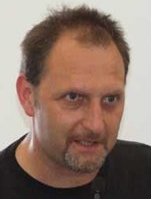 Ralf Heckel’s got an update on technical work being concluded on the German moonbuggy. His team is preparing to depart for the United States at the end of this week. Race time is nearly upon us!
Ralf Heckel’s got an update on technical work being concluded on the German moonbuggy. His team is preparing to depart for the United States at the end of this week. Race time is nearly upon us!
Our new, self-designed differential gear finished its first long-term test. There was normal abrasion after fabrication; a surprise was the abrasion of the brass — the carbon fiber pieces scraped at the brass rings. They are smaller after the 24-hour-test (1,5/100 mm). We bonded them together with two-component glue, and now the four small pinions work perfectly without abrasion.
Our electronics department is a disaster. Our student specialist leader is ill, so all the other students must make his work too. But it works! All components are working: data-logger, radiotelemetry, short message display, sensors. Now we assemble all together in our Telebuggy computer case. Tomorrow, our students must make a difficult cable tree with lots of data lines. One is a multiple clip located between the Telebuggy computer and the Moonbuggy. Such a clip [interrupted] a space shuttle launch last year. So it must be very secure.
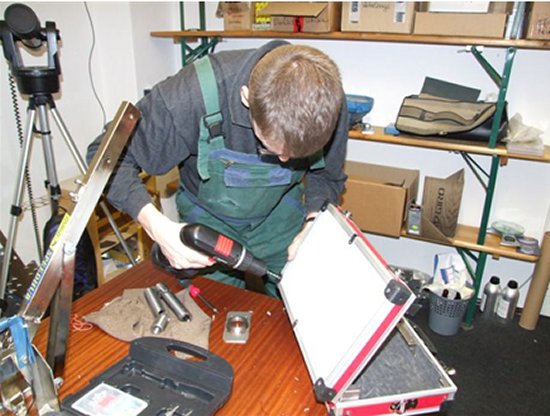
German moonbuggy CAD designer Fabian Hoffmann hard at work. (Photo: R. Heckel)
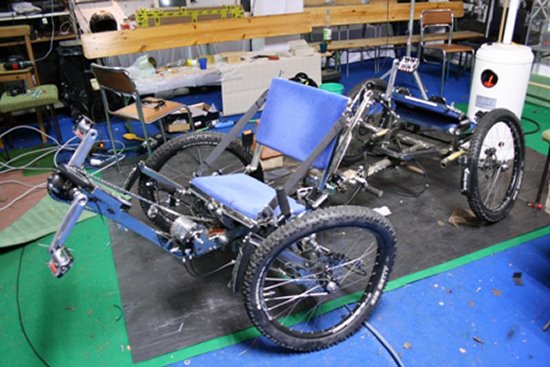
Primary work is complete on the German team’s 2009 moonbuggy.
Y’all ready for this? (Photo: R. Heckel)
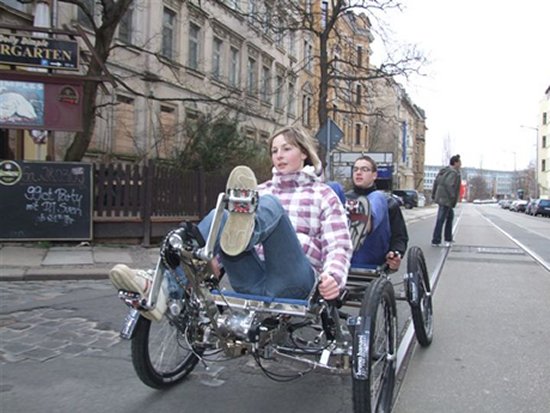
German moonbuggy teammates Lisa Hartenstein and Thommy Knabe put the
buggy through its paces in bustling Leipzig, Germany. (Photo: R. Heckel)
On March 24, our partner team and their professors from the Moscow Aviation Institute visited us. All liked to ride the moonbuggy. All want to be a part of our Russian team for 2010. The summer school for this team starts in summer 2009 in Leipzig. Also, we got an invitation to visit “the Krim” (Crimea) on the Black Sea. There is an international aerospace conference there for students — we should present the moonbuggy there. Near this place, former Russian rocket chief designer Sergei Korolyov tested his first self-constructed plane.
Heckel and the moonbuggy team also visited recently with Germany’s next generation of Olympic hopefuls at the “High School for Sports” in Leipzig. Check it out at http://www.sportgymnasium-leipzig.de/.
This is Germany’s “elite school of sports” — the most successful school for training of the national Olympics teams’ future generations.
Students of athletics and bicycle sports were testing the moonbuggy. This was a complete new experience for all — it was fun and was the ignition for a lot of discussions. The event was organized by the science advisor at the school and by the German Space Education Institute.
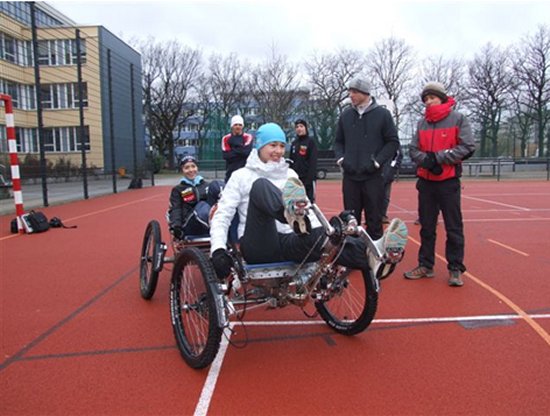
German sports students — potential future Olympians — try out the moonbuggy
and talk sports strategy with the GMBR team from the German Space
Education Institute. (Photo: R. Heckel)
The science results of the moonbuggy team are an inspiration for the sport students. Now they are ambassadors for the moonbuggy spirit at the next Olympic games.
Glad to see Germany’s moonbuggy team making such an international impact, and we look forward to the Russian team’s entry in 2010! Certainly, the Germans are putting together a formidable entry in pursuit of this year’s new “Best International Team Race Time” award, one of numerous prizes NASA and its corporate sponsors will present to participants in the 2009 Great Moonbuggy Race.
Will YOUR team take home a prize? We’ll find out in a few short days!

If I remember correctly the lunar surface is covered in a fine dustlike surface, so fins for the lunarbuggy might be a good idea.
That’s true — but the dust poses a more interesting challenge, and a “stickier” one, as we prepare to return to the moon for long-duration stays. Scientists theorize that lunar dust is electrostatically charged by incidents of high ultraviolet solar radiation and by the solar wind. When ultraviolet radiation hits the Moon’s “day side,” the half that faces the Sun, it knocks electrons out of atoms in the lunar soil. This creates a positive charge in countless dust specks, which repel one another the way identically charged magnets react in close proximity. Charged dust, scientists theorize, is pushed upward, often rising hundreds of feet in a phenomenon dubbed “fountaining.” The particles then discharge, sink to the surface and the cycle repeats. On the Moon’s night side, the solar wind has the same effect, but instead of positively charging atoms, it creates negatively charged ones. The dust behaves identically there, however, fountaining until the particles discharge and fall back.
All that sticky dust tends to cling to equipment, vehicles, hardware and astronauts! To date, we’ve never stayed on the moon long enough for lunar dust to be a real issue, but right now NASA scientists and their colleagues in industry and academia are studying ways to mitigate and repel lunar dust — to keep the buggies running smoothly and all other lunar operations five-by-five.